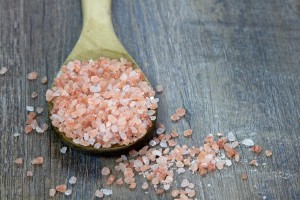We talked about how adjusting to extreme carbohydrate restriction can cause uncomfortable side effects because the body takes time to get used to making ketones and using this new source of energy.
As your body is adjusting to ketosis, you might experience “keto flu”. Certain electrolytes may help minimize these symptoms.
Make sure to talk to your physician before you embark on the keto diet, especially if you have existing health condition(s).
Sodium
What is one of the biggest health myths? Salt. We are told that we should avoid salt at any cost. If you are fit and healthy, and following keto diet, you will lose water and sodium in the first few weeks of the diet. This is even more so for athletes because as you sweat, your sodium and blood volume will decline. This can dramatically affect your energy and performance.
On the flip side, if you’re overweight, out of shape or in poor health then your body is likely already holding on to too much sodium from high consumption of packaged and processed foods (i.e. sodium is used as the primary preservative) or from chronically elevated insulin levels. Therefore, a low-carb or keto approach is great way to restore healthy levels.
Some of the symptoms of low sodium are fatigue and headaches, especially in hot weather. In more serious cases, you might even pass out. In the first few weeks on a keto diet, only about half of your weight loss is from body-fat. The other half is from water and sodium loss. Therefore, getting enough sodium is crucial.
When on a keto diet, aim for an extra 1,000-2,000mg of sodium daily.
The best sources of sodium are:
- Broth or bouillon (1-2 cups per day)
- Pink Himalayan or Celtic Sea salt (not standard table salt)
- Shellfish (i.e. oysters, mussels, crab, etc.)
Athletes should aim to take one gram 30 minutes before workouts to offset adverse effects of low sodium on performance.
Potassium
When you lose sodium on a keto diet, the salt depletion causes a parallel loss of potassium. The medical term for is hypokalemia.
Common symptoms of a potassium deficiency include weakness, muscular cramps, constipation, irritability or skin problems. In athletes, low potassium can compromise lean muscle mass which will ultimately impact performance, and in more severe cases, you may experience heart palpitations, irregular heartbeats, and respiratory distress.
Here is a list of some potassium rich keto-friendly foods:
- Asparagus (1/2 cup) – 202mg
- Avocado (1/2 medium) – 320mg
- Beef (3 oz) – 315mg
- Chicken breast – 330mg
- Broccoli (1/2 cup) – 230mg
- Salmon (3 oz) – 326mg
- Spinach (2 cups) – 330mg
Magnesium
Have you ever had muscle cramps? Lack of magnesium might have something to do with it. Magnesium is called the body’s “calming” mineral. It helps to keep your brain, heart and muscles relaxed. It’s also essential for protein synthesis, blood sugar control, energy metabolism and over 300 other biochemical reactions in the body. Intense exercise, lack of sleep, and stress can all deplete magnesium levels.
Vegetables get their deep green color from chlorophyll, and the core of the chlorophyll molecule is magnesium. If you think you have magnesium deficiency, make sure to eat plenty of leafy greens. The darker the leafy green, the more magnesium.
Animal protein is also a great source of magnesium. Shellfish like oysters and mussels are excellent ways to get more magnesium.
- Avocado (1/2 medium)– 30mg
- Oysters (3 oz.) – 80mg
- Pumpkin Seeds (1/8 cup) – 90mg
- Spinach (1 cup cooked) – 157mg
- Swiss Chard (1 cup cooked) – 154mg
- Yogurt (Plain) – 50mg
Do you have tips or comments on how to optimize keto diet? Share it with us.

